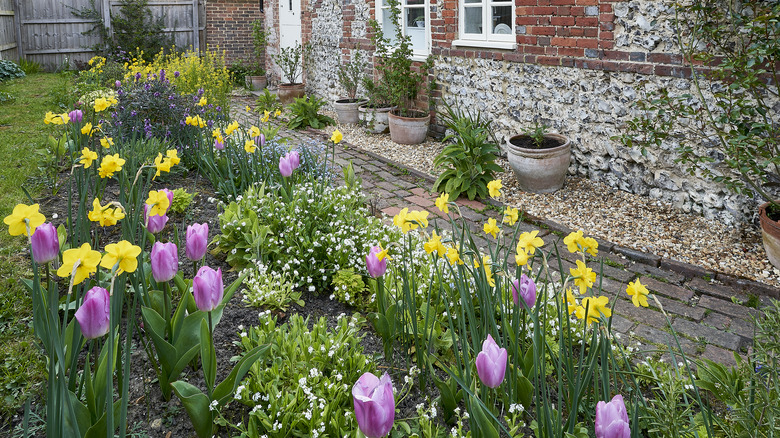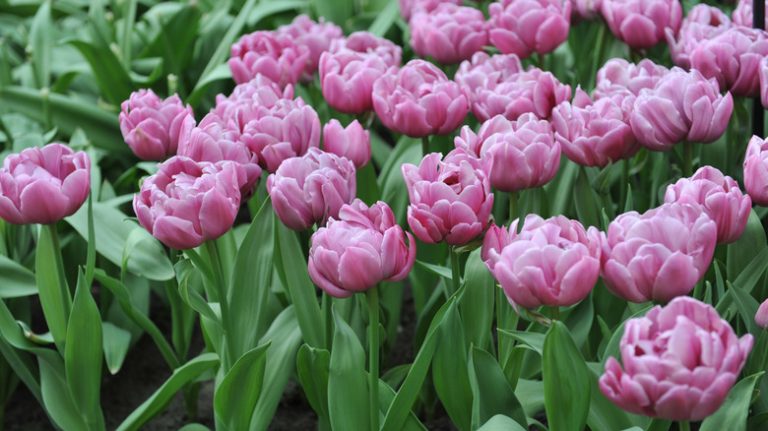A cottage garden is usually full of colorful perennials with room for some annuals, but what about spring-blooming bulbs? These are bulbs that come back year after year and are perfect for adding some charming colors and textures to the spring palettes of your cottage garden. In addition to classic daffodils, hyacinths, and tulips, there are many other bulbs suitable for making your cottage garden come alive in the spring.
A classic English-style cottage garden often follows the advice of English-garden designer and horticulturist Gertrude Jekyll, who originated the technique of planting flowers in long drifts, rather than square blocks, to help create compelling zones of color. You can emulate this idea by planting your bulbs in groupings near your other perennials for a colorful showcase in the spring before the rest of your cottage perennials start their bloom season.
Daffodils are a good starting point and add real charm to a spring cottage garden. The common wisdom for planting daffodils is to do so before hard frost, usually by the end of October. But, most spring bulbs can be planted as long as the ground can still be worked. As long as the ground isn’t frozen, for example, tulips can be planted as late as December. So, you can still get some colorful bulbs in as the autumn season winds down. Some suggested spring-blooming flowers for a cottage garden include crocuses, snowdrops, scillas, Dutch hyacinths, glory-of-the-snows, muscari, bluebells, dwarf irises, Grecian windflowers, camassias, and alliums.
Best early to midspring blooming bulbs for cottage gardens
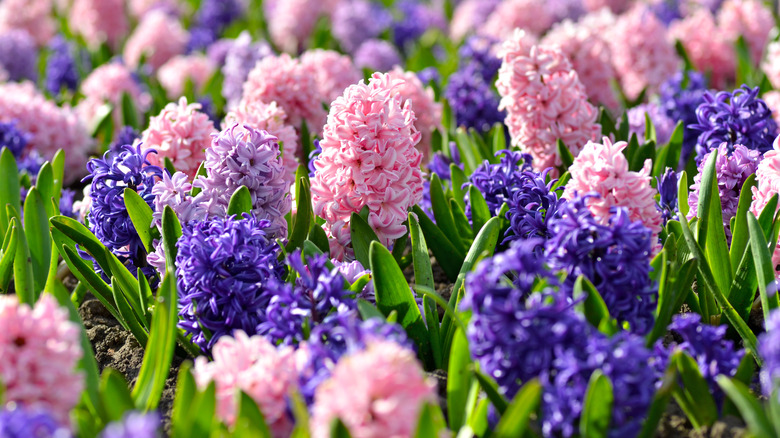
Cottage gardens are all about an abundance of color and texture. Spring-blooming bulbs come in a wide variety and a cottage garden is the perfect situation for experimenting with different ones. Plant a variety of bulbs that bloom from early through late spring for maximum impact. You can’t beat colorful, reliable crocuses, which start blooming as early as February in some areas. They’re small, so plant them in front of taller spring bloomers. White snowdrops, blue scillas, and pale blue striped squills are also small, early-blooming bulbs you can plant in the fall.
The next colorful spring bulbs to bloom are Dutch hyacinths. These produce low-growing but large, dense clusters of very fragrant flowers in a rainbow of colors. You can plant assorted colors together or clumps of the same color or variety. Muscari, commonly called grape hyacinths, bloom next in vibrant shades of blue and violet with some white and pale pink varieties. Muscari increase in number, producing more blooms each year.
Spanish bluebells come in shades of white, pink, and pale violet-blue, and bloom just before English bluebells. Both types do well in dappled sun-shade locations. Spanish bluebells tend to increase and spread readily throughout the garden. Another reliable spring bloomer is the tiny Grecian windflower, producing small daisy-like flowers in colorful shades of blue and violet.
Best late spring-blooming bulbs for a cottage look
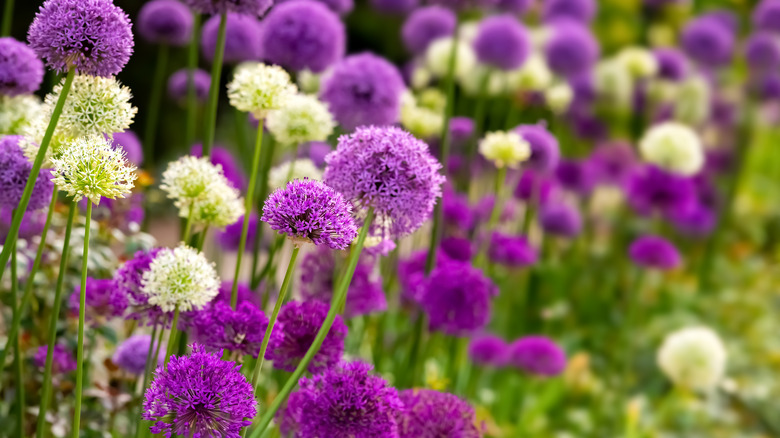
Some beautiful bulbs bloom in late spring — late April through early June — adding delightful color and texture to a cottage garden. One of these is camassia, also known as wild hyacinth, though it is actually part of the asparagus family of plants. The flowers have multiple stems with clumps of delicate, star-like clusters of blue or white. These bulbs increase in size over time and will put out more stalks of flowers; they can be divided and replanted every few years.
Camassias look similar to alliums, though some allium varieties grow much taller. Alliums are wild garlic plants that form round starbursts of tiny flowers. They come in a range of sizes and colors, including white, purple, magenta, and blue. Some have very large flowers, like Globemasters, and some are smaller, like the pretty blue Allium caeruleums. Others are large single stalks and some grow in multiples, like Millenniums. They bloom from late spring to early summer. Plant them in groups for a dramatic show in the garden.
In addition to Grecian windflowers, which bloom in early spring, some anemones bloom in late spring that also grow from bulbs. Anemone coronaria — taller, darker blue anemones – add vivid color to the cottage border. Common varieties are the blue poppy, Mr Fokker, de Caen blue, and Galilee blue.
Tulips are versatile spring bloomers
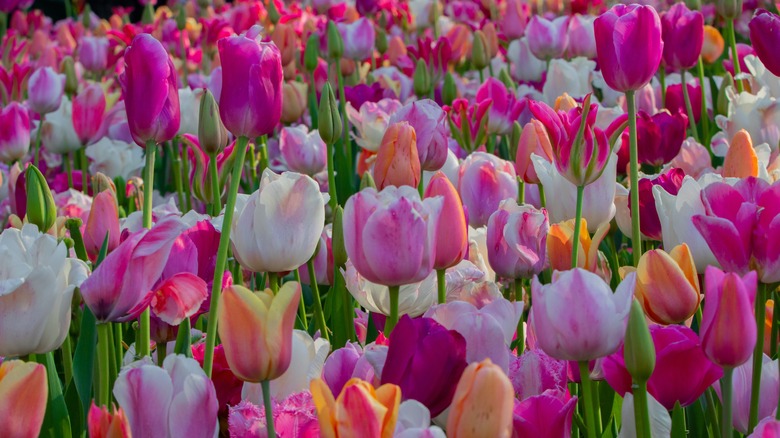
Seasonsoflife/Shutterstock
No cottage garden bulb display is complete without tulips. Tulips come in a variety of sizes, colors, and bloom times. Varieties blooming from early spring to May make tulips versatile for any garden design. They look dramatic in huge swaths, but for a charming cottage look, plant small clumps of five to 10 tulip bulbs throughout your garden. Planting several varieties of one color, like pink or orange, creates a subtle, sophisticated look. Or, mix some bold or pastel colors for an eclectic look.
Recommended early varieties include botanical tulips like Lizzy (red-orange) and Norah (rose pink); Emperor tulips like Albert Heijn (pale pink), Orange Emperor, and Flaming Purissima (white-streaked pink); and single early tulips like Purple Prince (medium purple) or Candy Prince (candy pink). Midspring bloomers are Bastogne (dark red triumphs), Ballerina (orange lily-flowering), Danique (species tulip), Barcelona (fuchsia triumph), Blue Spectacle (purple peony-flowering), and Darwin hybrid tulips like Daydream (yellow-orange) or Apricot Delight (pink-peach). Beautiful May bloomers include single late tulips like Queen of Night (dark purple) and Blushing Beauty (gold and pink), double lates like Mount Tacoma (white) or Carnaval de Nice (red-and-white striped), and viridiflora tulips like Greenland (pink-and-white-streaked green).
Bloom times given in most garden catalogs should be accurate. However, in some regions and in some weather conditions — if deep snow remains through spring, for example — you may find your tulips bloom a bit earlier or later. Experiment with different varieties in your cottage garden to see an array of colors throughout the entire spring season.

